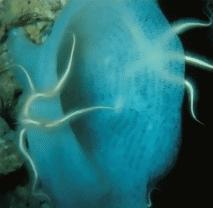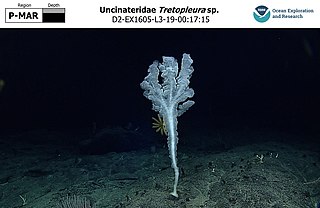
Halichondriidae is a family of sea sponges belonging to the order Suberitida. These sponges have a skeleton consisting of dense bundles of spicules occurring in a more or less random pattern.

Lyssacinosida is an order of glass sponges (Hexactinellida) belonging to the subclass Hexasterophora. These sponges can be recognized by their parenchymal spicules usually being unconnected, unlike in other sponges in the subclass where the spicules form a more or less tightly connected skeleton. Lyssacine sponges have existed since the Upper Ordovician, and three families are still alive today. The Venus' flower basket is one of the most well-known and culturally significant of the glass sponges.

Euplectellidae is a family of glass sponges (Hexactinellids) belonging to the order Lyssacinosa, first represented in the Ordovician fossil record, substantially older than molecular estimates of the clade's age.

Rossellidae is a family of glass sponges belonging to the order Lyssacinosa. The family has a cosmopolitan distribution and is found at a large range of depths.

Caulophacus is a genus of glass sponges belonging to the subfamily Lanuginellinae.

Staurocalyptus is a genus of sponge. It was circumscribed in 1897 by Isao Ijima.

Amphidiscosida is an order of hexactinellids. The Amphidiscosida are commonly regarded as the only living sponges in the subclass Amphidiscophora.
Acanthascus is a genus of sponges in the family Rossellidae. Species include:
Sceptrulophora is an order of hexactinellid sponges. They are characterized by sceptrules, a type of microsclere with a single straight rod terminating at a bundle of spines or knobs. An anchor- or nail-shaped sceptrule is called a clavule. A fork-shaped sceptrule, ending at a few large tines, is called a scopule. A broom-shaped sceptrule, ending at many small bristles, is called a sarule.

Farrea is a genus of glass sponges in the family Farreidae.

Euretinae is a subfamily of glass sponges in the family Euretidae.

Lefroyella is a genus of glass sponges in the subfamily Euretinae, containing 2 species.

Tretodictyidae is a family of glass sponges in the order Sceptrulophora.
Anomochone is a genus of glass sponges in the family Tretodictyidae.

Aphrocallistidae is a family of hexactinellid sponges in the order Sceptrulophora.

Aspidoscopulia is a genus of glass sponge in the family Farreidae.

Uncinateridae is a family of glass sponges in the order Sceptrulophora.
Claviscopulia is a genus of glass sponge in the family Farreidae.
Lonchiphora is a genus of glass sponge in the family Farreidae.
Diapleuridae is a family of glass sponges in the order Lychniscosida. The only living species, Scleroplegma lanterna, is endemic to the waters around Cuba and St. Croix in the Caribbean Sea.














